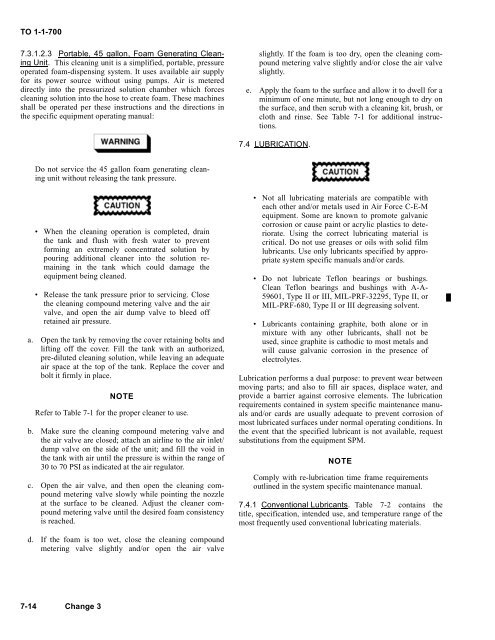TO 1-1-700 - Robins Air Force Base
TO 1-1-700 - Robins Air Force Base
TO 1-1-700 - Robins Air Force Base
You also want an ePaper? Increase the reach of your titles
YUMPU automatically turns print PDFs into web optimized ePapers that Google loves.
<strong>TO</strong> 1-1-<strong>700</strong><br />
7.3.1.2.3 Portable, 45 gallon, Foam Generating Cleaning<br />
Unit. This cleaning unit is a simplified, portable, pressure<br />
operated foam-dispensing system. It uses available air supply<br />
for its power source without using pumps. <strong>Air</strong> is metered<br />
directly into the pressurized solution chamber which forces<br />
cleaning solution into the hose to create foam. These machines<br />
shall be operated per these instructions and the directions in<br />
the specific equipment operating manual:<br />
slightly. If the foam is too dry, open the cleaning compound<br />
metering valve slightly and/or close the air valve<br />
slightly.<br />
e. Apply the foam to the surface and allow it to dwell for a<br />
minimum of one minute, but not long enough to dry on<br />
the surface, and then scrub with a cleaning kit, brush, or<br />
cloth and rinse. See Table 7-1 for additional instructions.<br />
7.4 LUBRICATION.<br />
Do not service the 45 gallon foam generating cleaning<br />
unit without releasing the tank pressure.<br />
• When the cleaning operation is completed, drain<br />
the tank and flush with fresh water to prevent<br />
forming an extremely concentrated solution by<br />
pouring additional cleaner into the solution remaining<br />
in the tank which could damage the<br />
equipment being cleaned.<br />
• Release the tank pressure prior to servicing. Close<br />
the cleaning compound metering valve and the air<br />
valve, and open the air dump valve to bleed off<br />
retained air pressure.<br />
a. Open the tank by removing the cover retaining bolts and<br />
lifting off the cover. Fill the tank with an authorized,<br />
pre-diluted cleaning solution, while leaving an adequate<br />
air space at the top of the tank. Replace the cover and<br />
bolt it firmly in place.<br />
NOTE<br />
Refer to Table 7-1 for the proper cleaner to use.<br />
b. Make sure the cleaning compound metering valve and<br />
the air valve are closed; attach an airline to the air inlet/<br />
dump valve on the side of the unit; and fill the void in<br />
the tank with air until the pressure is within the range of<br />
30 to 70 PSI as indicated at the air regulator.<br />
c. Open the air valve, and then open the cleaning compound<br />
metering valve slowly while pointing the nozzle<br />
at the surface to be cleaned. Adjust the cleaner compound<br />
metering valve until the desired foam consistency<br />
is reached.<br />
• Not all lubricating materials are compatible with<br />
each other and/or metals used in <strong>Air</strong> <strong>Force</strong> C-E-M<br />
equipment. Some are known to promote galvanic<br />
corrosion or cause paint or acrylic plastics to deteriorate.<br />
Using the correct lubricating material is<br />
critical. Do not use greases or oils with solid film<br />
lubricants. Use only lubricants specified by appropriate<br />
system specific manuals and/or cards.<br />
• Do not lubricate Teflon bearings or bushings.<br />
Clean Teflon bearings and bushings with A-A-<br />
59601, Type II or III, MIL-PRF-32295, Type II, or<br />
MIL-PRF-680, Type II or III degreasing solvent.<br />
• Lubricants containing graphite, both alone or in<br />
mixture with any other lubricants, shall not be<br />
used, since graphite is cathodic to most metals and<br />
will cause galvanic corrosion in the presence of<br />
electrolytes.<br />
Lubrication performs a dual purpose: to prevent wear between<br />
moving parts; and also to fill air spaces, displace water, and<br />
provide a barrier against corrosive elements. The lubrication<br />
requirements contained in system specific maintenance manuals<br />
and/or cards are usually adequate to prevent corrosion of<br />
most lubricated surfaces under normal operating conditions. In<br />
the event that the specified lubricant is not available, request<br />
substitutions from the equipment SPM.<br />
NOTE<br />
Comply with re-lubrication time frame requirements<br />
outlined in the system specific maintenance manual.<br />
7.4.1 Conventional Lubricants. Table 7-2 contains the<br />
title, specification, intended use, and temperature range of the<br />
most frequently used conventional lubricating materials.<br />
d. If the foam is too wet, close the cleaning compound<br />
metering valve slightly and/or open the air valve<br />
7-14 Change 3
















